Electric Scooter Buying Guide
Posted by Tom Lee on
Electric Scooter Buying Guide
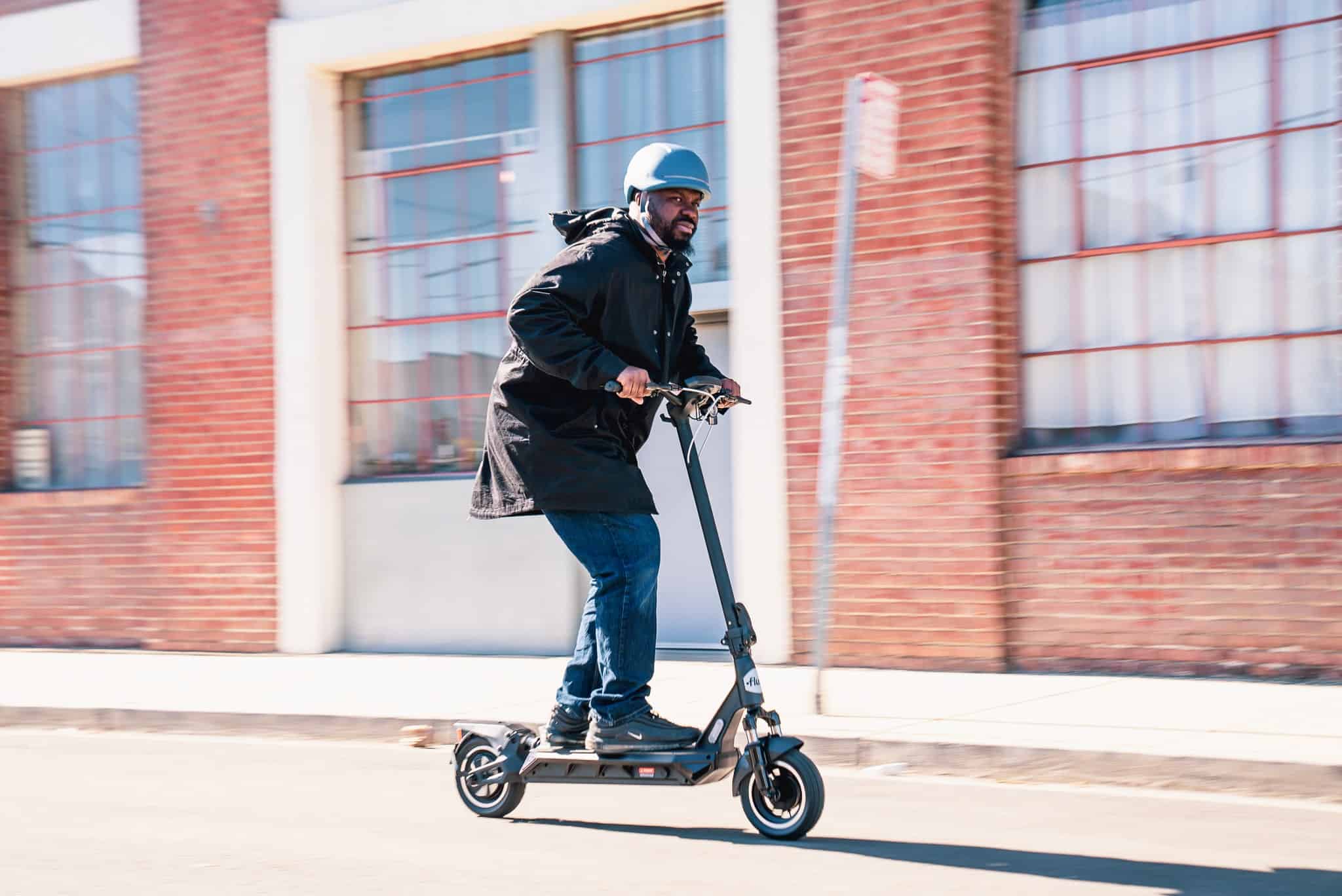
The Electric Scooter Buying Guide is divided into a few sections. Feel free to use the links below to jump straight to what you’re looking for.
If you’re totally new to electric scooters, then it’s helpful to read the whole guide.
Not sure you’re in the right place? We have lots of other guides
-
- Our most recent Editor’s Choice of Best Electric Scooters that we’ve reviewed.
-
- Our recommendations for the Best Electric Scooters for New Riders.
-
- Make in-depth technical and price comparisons.
-
- Compare real-world performance, including range and hill climb tests for the different scooters.
- Our article on how to ride an electric scooter. And once you have the basics down, look at our top tips for pro riders.
Maybe you’re in a bit of a rush and would rather watch a video on how to select the scooter that best suits your needs. Well, we’ve got you covered. Here’s a video by Chuck, where he goes into great detail explaining things beginner buyers need to know. You also get several recommendations.
Buying an Electric Scooter
Purchasing an electric scooter can be a formidable challenge — there are an overwhelming number of choices and things to consider. A quality electric scooter can easily run you $400; but, at the same time, can also cost upwards of $3,000. Throwing a wrench into the matter are numerous dubious sites with “reviews” from people who have never touched a scooter in their life. As you will find in this guide, electric scooters vary greatly in style, price, features, origin, and even customer support.
RG: Your Trusted Source of Hands-On Reviews
We are seeing new scooter brands pop up all the time, and there’s a good reason.
Electric scooters are cheaper to own, operate, and store than traditional automobiles (cars). They are also more convenient than public transportation, and it is much easier to escape traffic jams when riding in the bike lane. Whether you’re looking to make a scooter your everyday commuter or just want to add some octane to your life, we’re here to guide you through the process.
Why should you take our word for it?
We’re Rider Guide (RG), a small team that has spent hundreds of hours riding thousands of miles and reviewing 120+ electric scooters (and counting) since 2018. We’ve experienced every type of scooter from every known brand and believe we’re the people you can rely on for the most unbiased scooter reviews. We are not a retailer.
Our source of confidence?
We’ve tested more scooters than anyone in the industry, and as you know (or are about to find out), no one pushes their scooters as hard as we do. We also stay on the pulse of e-scooter news; we attend and participate in Micromobility conferences; we interact with the riders and deliver their concerns to brands and distributors; and we provide a fun hub where riders can feel like part of a community across all major social media platforms.
Our hands-on review process include RG-certified testing of real-world range, top speed, acceleration, braking, and hill climbing ability. We are very, very thorough. We record details on every aspect — from unboxing and assembly to performance and build. The RG team inspects every port, cable connection, joint, and even the instruction manual to ensure we share the most complete information. We report our findings in written and video reviews to help you find the best scooter for your needs.
- To buy an electric scooter without doing the research, pick one from our curated RG Editor’s best electric scooters list.
- If you’re focused on budget, we also have reviews on top-rated scooters organized by $400, $1000,$1500, $2000, $2500, and $4,000 price ranges.
- If seeing is believing, check out scooters in action in the review videos on our YouTube channel.
Electric Scooter Categories
It’s not easy knowing where to start, especially when you’ve not had prior interactions with electric scooters. Not to worry, that’s why we’re breaking this section into price categories, with what to expect in each, the suitability of featured scooters for your riding experience, and what you get by stretching your budget a little more.
Budget Electric Scooters (<$400)
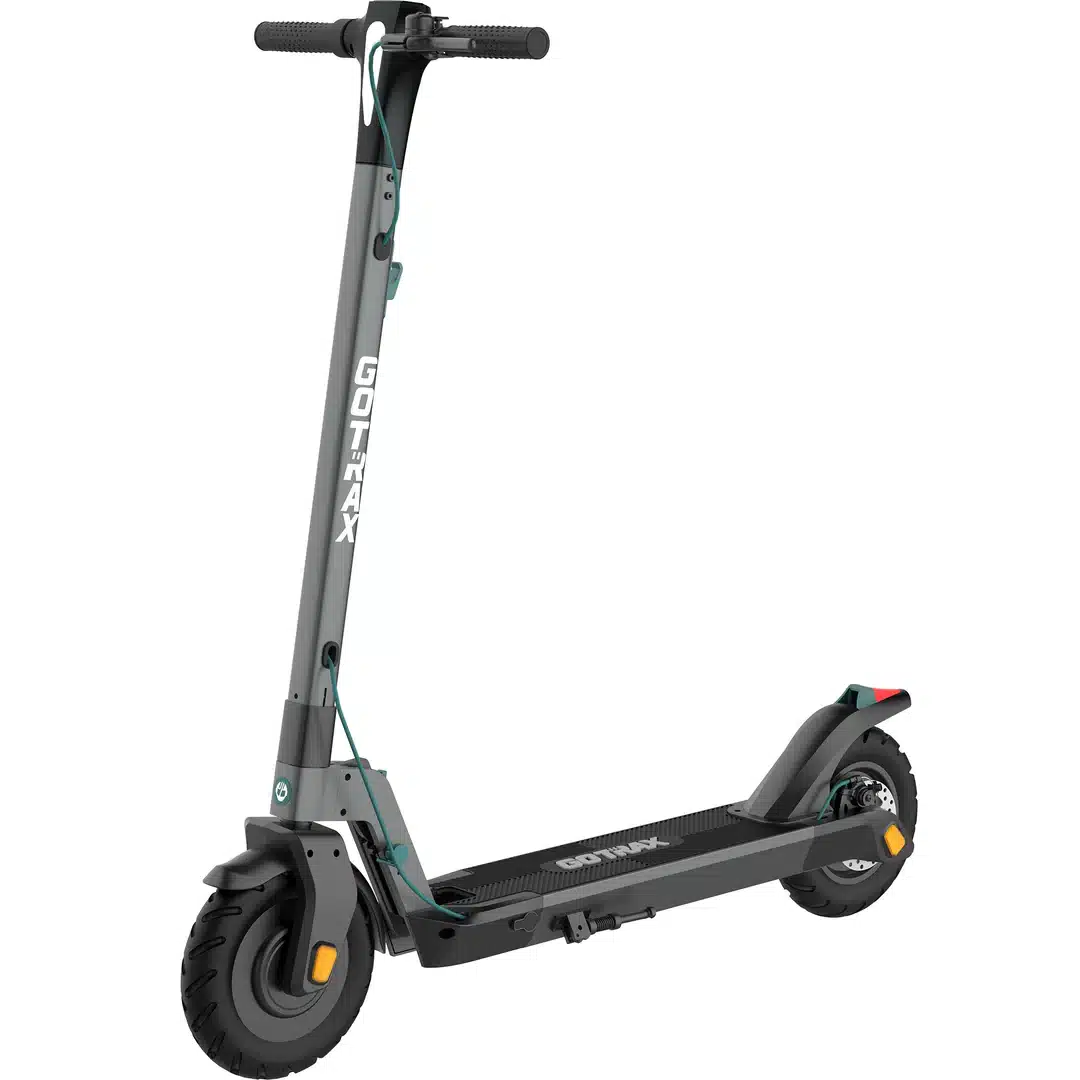
Most budget e-scooters are not recommended for anything more than light recreational use, such as errands or short commutes on well-paved roads with minimal hills. For daily or frequent use, especially over rough terrain, a more powerful model would be better suited.
These budget models generally come equipped with an under-powered motor, similar to that on a shared scooter (below 300W), and offer little in the way of range – typically 8-10 miles. Top speed is usually capped at 15 mph, and they often feature just a single mechanical brake which generally provides weak braking capabilities.
Despite their lower price points, some models in this category still offer outstanding features and performance for the money. Quality doesn’t always have to come with a hefty price tag!
See Editor’s Choices for Best Electric Scooters Under $400.
Commuter Electric Scooters ($400 to $2000)
The commuter class of electric scooters is the biggest one and therefore divided into three categories. At these price points, we generally find that scooters are fairly balanced in terms of features, quality, and performance.
Budget commuter (<$1000)
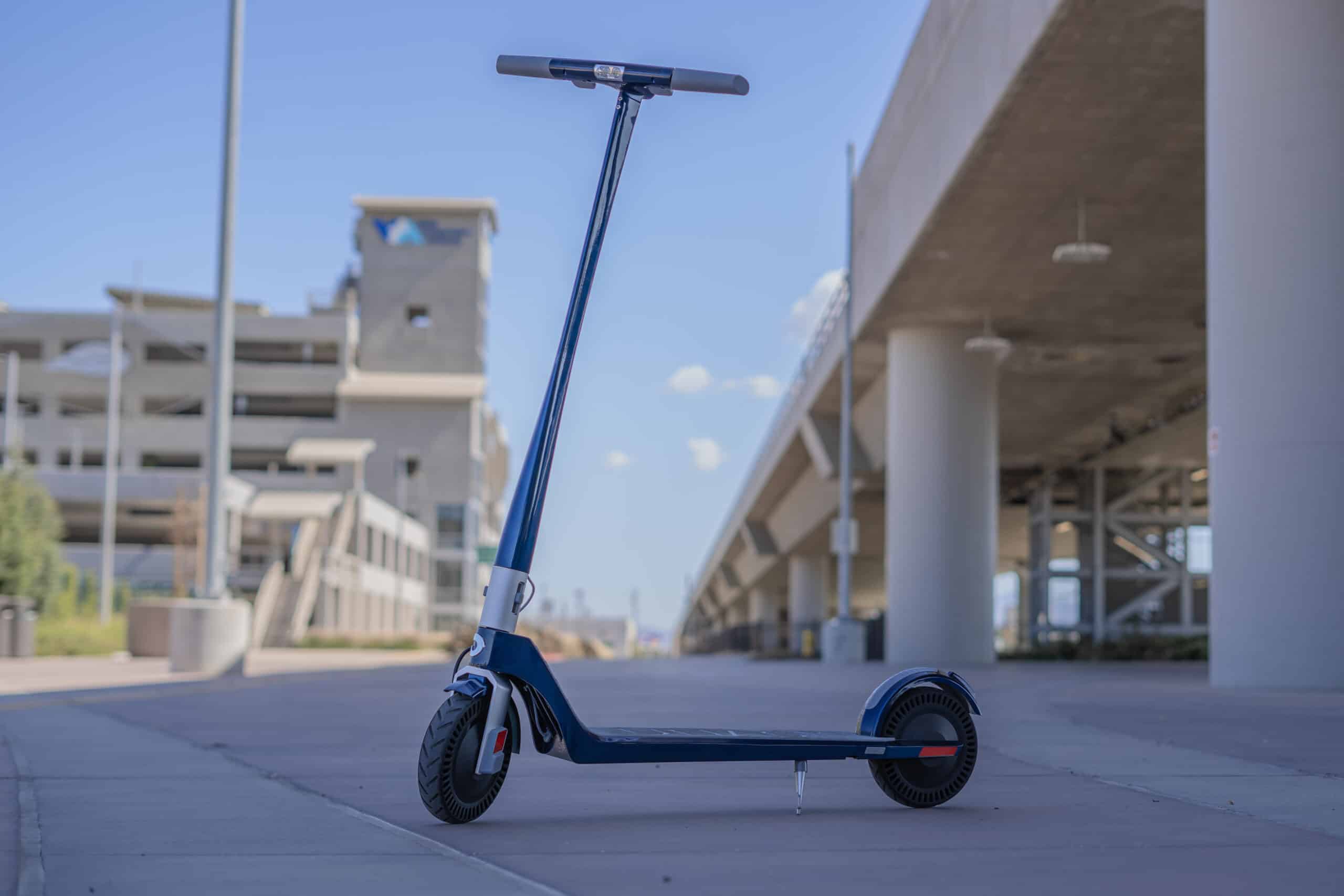
The budget commuter category of electric scooters brings a considerable upgrade in terms of power, range, speed, braking, general performance and handling.
You’ll be able to ride further and faster with these models, with speeds of up to 20 mph miles and tested ranges of up to 15 miles being common for this category. Furthermore, the braking system in these models has been upgraded to reduce the stopping distance significantly.
These scooters are better built and designed for daily commuting on smooth surfaces and have enough power to tackle moderate hills on your commute. At the same time, they remain lightweight, usually weighing below 40 lbs, making them easy to fold up and take with you anywhere.
This class of scooters also usually comes with powerful motors (with wattage ranging from 300W to 800W), making them reliable and responsive compared to their budget electric counterparts/shared Scooters. In addition, you will see the incorporation of suspension into some models.
A trend exclusive to this category is a mixed tire configuration with a front air-filled and a solid rear tire, providing the optimal trade-off between comfort and maintenance. All electric scooters up to $1000 are single-motor scooters, except, of course, the Unagi E500. You will see scooters with two or dual motors in the next category.
See RG Editor’s Choices for Best Electric Scooters Under $1000
Mid-ranged Commuter Electric Scooters (< $1,500).

This is where the fun really starts. All important performance metrics and features get massive improvements and most scooters in the category now have suspension. They often have larger batteries and motors than the budget commuter counterparts, allowing for longer range and higher top speeds.
Many of these scooters now come with motor power rated up to 1000W and even dual motor configurations in some for improved acceleration and better hill-climbing capabilities. They typically boast top speeds of over 25 mph and a range of more than 20 miles per charge.
However, increased features and performance come at the cost of weight with many models tipping the scales over 40 lbs, making them less portable and will certainly give you a workout when carrying.
See RG Editor’s Choice for Best Electric Scooters Under $1500
Premium Commuter Electric Scooters (< $2,000)
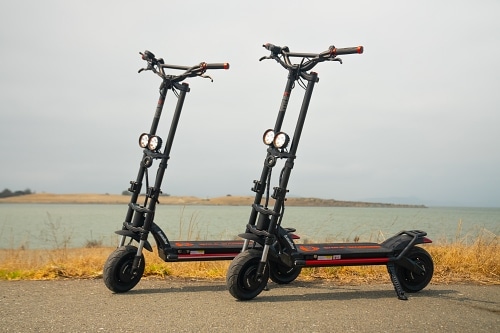
The premium commuter class of electric scooters offers riders a more comfortable, safer, and longer-range ride than their budget and mid-range counterparts. The improvements come in the form of better suspension, larger motors, bigger batteries, and better brakes.
However, these upgrades (again) come at a tradeoff–increased weight, with some scooters exceeding 60 lbs. This makes loading into a car or carrying upstairs more difficult.
The typical top speeds for premium scooters hover around 30mph and above, while the range can be as far as 25 miles or more on a single charge. Motor power is between 1000W to 2000W, with dual motor configurations that boost the scooter’s performance.
In addition, these scooters have an increased rider weight capacity to accommodate heavier riders–up to 330 lbs in some cases!
See RG Editor’s Choice for Best Electric Scooter Under $2000
Performance Electric Scooters (<$2,500)
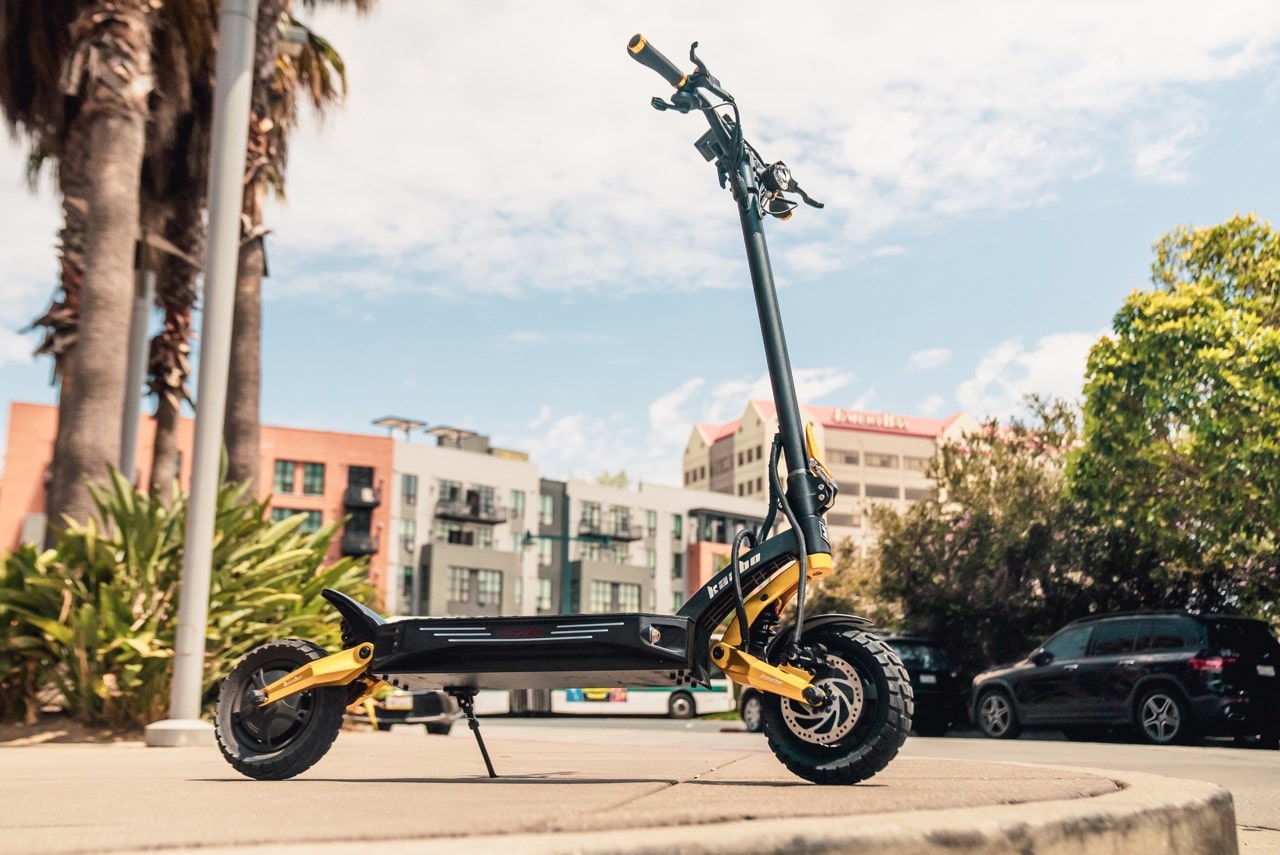
Think of performance scooters as luxury commuters that offer riders either serious speed or ultra-long range. With powerful dual motors providing up to 2000W of power, these scooters can reach maximum speeds of 40 mph and are able to tackle most hills with relative ease. The battery capacity on these scooters is also impressive, with most models having capacities of over 1000Wh, giving them a real-world range between 30 and 40 miles.
Many of the performance electric scooters also come with premium features that make them stand out from the crowd. These include large tubeless pneumatic tires(10-11 inches) as well as suspension systems for improved handling and ride quality, semi-hydraulic or hydraulic brakes for better braking performance and control, powerful lights and turn signals for increased visibility in low light settings.
In summary, performance electric scooters provide an ideal mix of speed, comfort, safety, range, and convenience all packaged into one machine.
See RG Editor’s Choice for Best Electric Scooters Under $2500
Extreme Perfomance Electric Scooters (< $4,000)
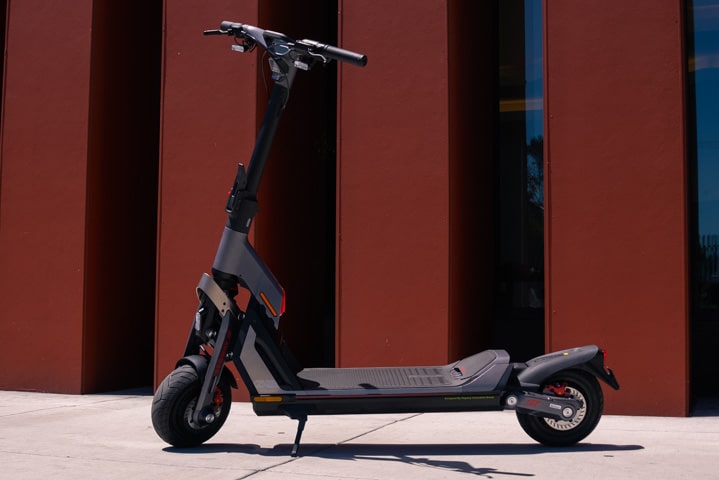
If performance electric scooters are like luxury vehicles, extreme performance scooters are like race cars. This is where the best dual motor scooters are and where acceleration is. They are the best in most categories, including build quality, ride quality and performance. With this improved performance, no one expects portability in this category.
With dual motors capable of achieving speeds in excess of 40 mph, extended battery life for long-range rides of up to 40 miles, and top-notch suspension, these scooters leave little to be desired. In addition, many extreme-performance scooters also include hydraulically activated disc brakes to ensure greater stopping power at these higher speeds.
They are also equipped with large pneumatic tires and powerful motors. This, plus the suspension, makes them perfect for off-roading.
The construction screams quality and craftsmanship. The decks are usually larger than those on regular electric scooter models and have a higher level of build quality for improved longevity and performance. Materials used for these types of electric scooters are generally top notch as well, ensuring that riders receive one of the best possible experiences when using them.
In terms of portability, however, these extreme performance scooters typically fail due to their hefty weights – usually exceeding 70 lbs in most cases. As such, individuals who need the ability to fold and carry their electric scooter should make sure they’re comfortable carrying this much weight before making a purchase.
Beast Electric Scooters (> $4,000)
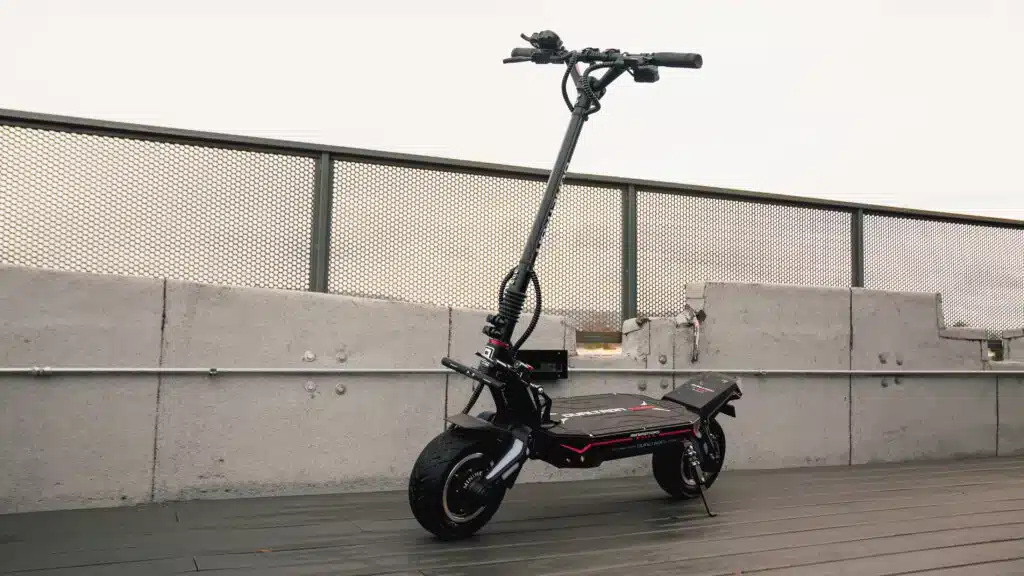
Beast electric scooters (sometimes known as racing or hyper scooters) offer an unmatched experience and are the pinnacle of electric scooter technology.These are the scooters that you’ll see all over YouTube because they attract a lot of attention, but you’ll rarely see them on the roads. Warning: these are not beginner scooters.
For those brave enough to take on the challenge of owning one, prices typically range between $4,000-$7,000 – so a hefty investment but no doubt worth it for anyone looking for an adrenaline rush!
At over 100 lbs, these scooters are certainly not portable. But what they lack in portability, they make up for with raw power and speed. They come equipped with powerful motors (3,000W- 7,000W) and battery capacities over 1500Wh. This enables them to reach speeds of 50 mph or even higher, depending on the model, as well as have exceptional acceleration and hill-climbing abilities. With such powerful batteries, they also boast long ranges, with some models able to cover up to 50- 80 miles on a single charge.
The impressive performance capabilities of Beast Electric Scooters are complemented by their excellent braking systems, which include disc brakes for enhanced stopping power.
Overall, Beast Electric Scooters provide a truly unique riding experience that takes electric mobility to a whole new level and are worthy of any enthusiast’s collection – just be aware that these high-performance machines require a certain amount of expertise and skill to operate safely.
See RG Editor’s Choice for Fastest electric scooters.
What to Consider When Buying an Electric Scooter
Now that we’ve gone over the price categories, let’s dive into some other topics that will likely influence which scooter you choose to purchase
Cost
When it comes to purchasing an electric scooter, the old adage holds true: you get what you pay for.
Generally speaking, higher-priced models provide features, performance, and quality that won’t necessarily be found in lower-priced options. The more money you spend on something, the greater its potential capabilities will tend to be. In other words, don’t expect to be getting any extreme beast scooter for $200
But that’s not to say that entry-level options aren’t a great purchase– after all, not everyone requires extreme performance.
If your budget is limited, an affordable electric scooter could still offer plenty of worthwhile features while still giving you a convenient and cheap way to commute.
In the end, it’s important to achieve a good balance between functionality and cost–at a price of $400 the electric scooter should at least have: a speed of around 15mph, a range of greater than 10 miles, an IP rating and basic lighting as well as reliable braking for safety.
Pro Tip: You can use the filter feature in our comparison database to set min and max limits for the price to a budget range that suits your needs. This will return all scooter options available in that range.
Range and Battery
Range refers to the distance a scooter can travel before it runs out of battery power. The range of your electric scooter will depend on various factors, including motor power, battery capacity, rider weight, scooter weight, weather, riding mode, and average speed.
To give consumers the most accurate and realistic range assessment, we perform rigorous real-world tests on every electric scooter we receive and display the data on our scooter database.
To ensure standardization and reliable results-our RG-certified range test is performed by the same rider on the same urban route with frequent stops, rough roads, and uphill climbs in the scooter’s highest performance mode. The 165 lb rider pushes the scooter to its limit, maxing out the throttle and riding until the battery dies completely.
There is no denying it, manufacturers have been known to overstate the range of their electric scooters. This is why we advise a cautious rule of thumb to err on the side of caution – take whatever they advertise and divide it by two. This is especially true given that the results from our electric scooter survey conducted in 2018 showed that many vendors overstate the actual range of their scooters by up to 30%.
To ensure you find the right scooter for your needs, calculate the number of miles you will cover for your regular commute (to and from) and then look for a scooter that can deliver that same amount with a few extra miles left as a buffer. This should give you plenty of leeway in case of unexpected events.
You can’t think about range without talking about batteries. In regards to this, two elements come into play: brand and battery capacity.
Known brands such as LG, Panasonic, and Samsung tend to be more reliable and have longer expected lifespans than generic brands.
When it comes to capacity (the amount of power stored in each battery–typically measured in watt hours (Wh) ); the higher the battery capacity, the greater its range will be. To illustrate this point: the Minimotors Dualtron X Limited has a 5,040 Watt hour LG battery that allows it to reach 86.4 miles of tested range, while the Segway Ninebot Air T15’s branded battery only offers 4.2 miles due to its comparatively lower capacity of 144 Wh.
However, like all batteries, your battery capacity (and scooter range) will diminish as time goes by. Most batteries will maintain their integrity for at least 300 to 500 charging cycles, with the best batteries enduring up to 1000 charging cycles before beginning to degrade.
Pro Tip: You can bring your charger with you or buy an extra charger to leave at your destination. Some high-performance scooters have dual charging ports, cutting charge time in half when using two chargers. You can also purchase an extra battery for scooters that have a removable battery configuration like the Anyhill UM-2, EMOVE RoadRunner, TurboAnt X7 Max, or Minimotor’s Dualtron Storm.
Weight and Portability
Portability is very important for scooters because it’s not just about folding the scooter up into a compact package, but also about moving it around when not in use. It is critical that you are capable of not just riding the scooter but also being able to carry or push it if necessary.
Most scooters with a reasonable range (>15 miles) will weigh over 25 lbs. Scooters far exceeding 30 lbs will be fairly difficult to carry for long durations, tough having a handle or shoulder strap can help bear the weight.
Some scooters have extra wheels or a folded configuration that allow them to be rolled along like the compact, commuter-friendly Fluid Freeride Horizon (13 Ah). However, even with such features, remember that at some point, the scooters might have to be carried upstairs or lifted into a vehicle. Case in point, even the highly portable Glion Dolly has folded dimensions of 37 in by 12 in by 8 in and weighs 28 lbs, which can be awkward for some to carry.
If you are in the market for recreational joyriding or beast mode off-roading and not focused on its portability, the weight is not as important a factor as build quality and top speed. But if you need an electric scooter for commuting to and from work daily, the vehicle you choose must be light enough and easy to transport. Every ounce counts, and those few pounds add up over time when you have to carry your electric scooter with you for every outing or over longer flights of stairs.
It’s recommended that the scooter should not exceed 30% of your body weight for you to handle it comfortably and with ease.
Just think about your commute:
- Will you need to walk upstairs?
- Does your destination have an elevator?
- Do you have permission and space to store your scooter inside (primarily in workplaces)?
- Do you have alternate transportation when poor visibility and/or inclement weather occur?
- Are you able to lift the scooter into a trunk?
Some conditions, like rainy weather, may also call for you to take public transportation or a rideshare home. Most drivers will allow you to put your scooter in the trunk, but you still need to be able to maneuver it into the vehicle yourself.
Pro Tip: For comparison, the average weight of a household standup vacuum cleaner is 12 lbs to 18 lbs, and many have similar dimensions to large folded scooters. Alternatively, visit a sporting goods store and pick up a few dumbbells or kettlebells to test what weight you can comfortably manage.
You can check out our review on the Best Lightweight Electric Scooters currently available on the market
Top Speed
When we think about scooters and their top speed, it’s natural to want the fastest ride possible. But most commuters really don’t need more than a max speed of 15 mph.
In fact, some municipalities have laws against going over 15 mph on electric scooters, and most restrict scooters from driving on pedestrian sidewalks.
And sure,15 mph might seem tame if you’re used to riding in cars, but in reality, it feels much faster on a scooter due to the smaller tire size and zippy acceleration capabilities.
If you’re looking for a thrill and are interested in extreme performance scooters, look to the Dualtron X Limited from Minimotors. This electric scooter can hit speeds of up to 60 mph, so it definitely offers some serious power. But remember, with that kind of speed comes great responsibility. If you want to stay safe while getting your thrills, serious safety gear is an absolute must.
Pro Tip: Always wear a helmet when riding your scooter at any speed.
Rider Weight
The max load or max rider weight is the weight limit that the electric scooter can support. For most scooters, this limit ranges from 220 lbs to 300 lbs. If you weigh more than this, you’ll want to ensure you’re looking at scooters that can support your weight. Not only would exceeding the manufacturer’s specified weight limit be dangerous, but it could also void the terms of your warranty.
Keep in mind that even if the scooter is rated for your weight and you’re at the top of the limit, it will be slower and have less range compared to a lighter rider. Not only that, but it can also put an increased strain on your electric scooter’s motors, batteries, and other components, which can lead to premature wear and tear or even damage.
Also, consider if you’ll be carrying a backpack or anything else that will add to the overall weight the scooter will bear. While many models of electric scooters will be able to manage up to 220 lbs without major problems, riders who are above that weight should focus on finding a scooter with at least a 500-watt motor – as it will likely have sufficient power for your size and carry more load satisfactorily.
Pro Tip: You can filter the comparison database based on rider weight.
Deck
The deck of an electric scooter plays a massive role in the overall riding experience. It’s important to consider its size, shape, material, and construction when selecting your ride.
First off, you need to consider the size and shape of the deck. Some offer enough standing room to place both feet flat, while others crowd your toes or require that your heels hang off the edge.
A larger deck means more room for maneuvering your feet as you ride, making it easier for beginners or those with big feet. On the other hand, a slimmer design may be better suited for smaller riders or those who want less bulk when transporting their scooter.
It’s also worth looking out for any design elements that might take up more space on the deck, like a stem folding mechanism or a rear wheel–these can affect how much room is available and how comfortable the ride will be. You’ll also want to ensure that whatever material they use on the deck provides good traction; often scooters will have grip tape or rubberized grooves just like on a skateboard.
Motor Power
Adult electric scooters have hub motors, which are brushless direct current (BLDC) electric motors built into the wheels’ hubs. All electric kick scooters have at least one motor, while more powerful ones will have dual motors.
Electric motors are rated based on their power consumption, which is expressed in units of watts (e.g., 600 watts). More powerful motors will have greater wattage. Motor power generally starts at 250 watts and goes all the way up to 6270 watts on the Minimotors Dualtron X Limited.
Budget electric scooters like the GOTRAX GXL Commuter v2 typically have a motor rating at or below 300W. Budget commuter scooters usually range between 300W-1000W, while mid-range commuter scooters have a motor rating of 500W-1500W. For more extreme performance options like the NAMI BURN-E 2, you’re likely to find a dual motor setup with each motor generating at least 1500W.
For adults, we do not recommend anything under 250 watts for daily commuting. This will be adequate for flat surfaces and very small hills. If you live in an area with steeper hills, think about going to 350 or 500 watts. Even with 500 watts, your scooter will slow down on medium-sized hills. Larger motors will not only help with powering up hills, but they will also get you up to top speed more quickly.
Suspension
Suspension, similar to that in a car, smooths out bumps and indentations in the road and improves ride quality. Without suspension, especially if you are using solid tires, every bump and indentation in the road will be felt while riding. If your commute or journey involves traversing rough terrain, having a scooter with suspension is essential.
There are three main types of suspension systems that are typically found on electric scooters: spring, hydraulic or air piston, and rubber suspension. Scooters with the best suspension will have some combination of a spring and piston — a combination called coil-over-hydraulic or coil-over-air.
Spring suspension is the simplest type of system, as it uses a coil spring to absorb bumps in the road. This type of system is usually found on lighter electric scooters and is generally affordable, but it provides less cushioning than other types.
Hydraulic or air piston suspensions are usually more expensive than spring suspensions but offer increased cushioning and performance. Hydraulic suspensions work by using an oil-filled cylinder. As you ride over bumps in the road, the oil inside compresses, absorbing the shock and providing a smoother ride. Air piston suspensions are similar to hydraulic ones but instead use air pressure instead of oil for their cushioning system.
Finally, rubber suspensions absorb shock and vibration using elastomer components (rubber cartridges) rather than steel coils. They tend to be fairly stiff but can easily be adjusted by swapping out the rubber cartridges for softer ones. A well-known example of such technology can be seen in Minimotors and Inokim electric scooters.
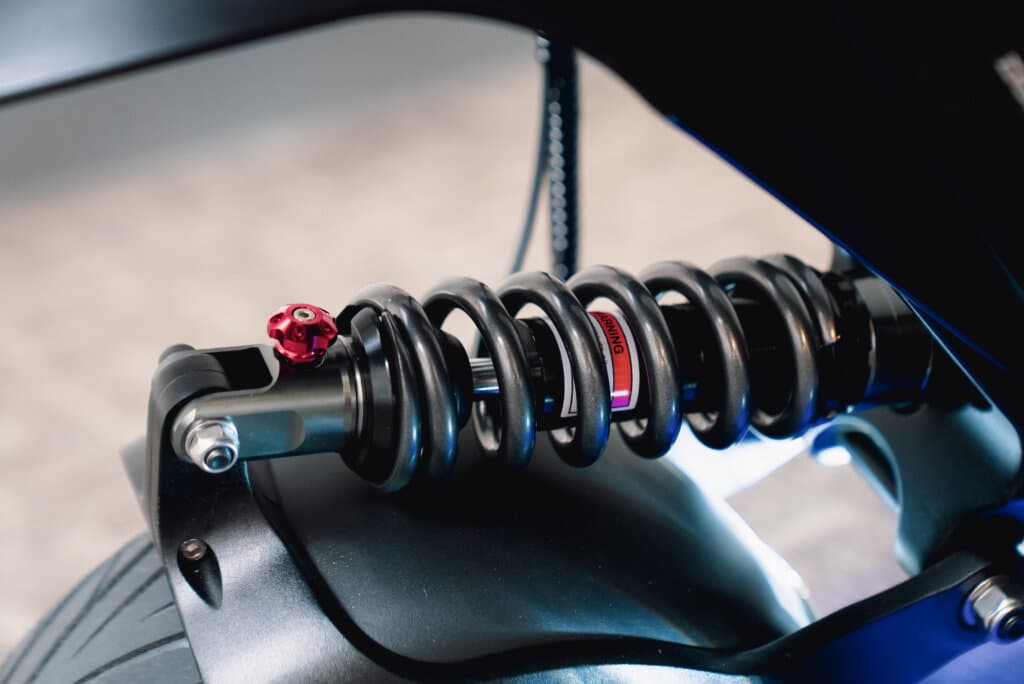
As the micromobility industry advances, manufacturers continue to innovate. Adjustable suspension systems are becoming increasingly common on scooters, and for riders that do a lot of riding or who simply enjoy customization down to the minor details, this development is incredibly beneficial. With an adjustable suspension system, they can customize their ride based on terrain conditions, the overall responsiveness of the system, and many other factors.
The type of suspension you get on your scooter will depend on your budget/price class. While budget-friendly options rarely incorporate any kind of suspension, brands like GOTRAX and Hiboy have recently pushed out scooters with basic suspension systems that can still provide a sort of smooth ride. However, this basic setup cannot be compared to what you get on more expensive models.
If you’re prepared to spend more than $1,000 on a scooter, then it’s almost certain that you’ll get some kind of suspension on either the front or rear wheel – if not both!
Some scooters, however, are forgoing the use of traditional suspensions in favor of large pneumatic tires. These tires provide a far superior form of damping than small, cheap spring suspensions. An example is the Taur, which uses 13-inch Continental brand tires to roll over obstacles.
Lighting

Before venturing out after dark, you should make sure that you are properly equipped with the right lighting. A standard white high-mounted front light and red rear light will certainly do the trick. However, if you’re looking to really stand out and be visible then stem and deck lights may give you an even more noticeable edge.
Due to the design of electric scooters, they typically do not have very visible rear lights. If you are going to ride at night, strongly consider adding some flashing red rear lights to your helmet or backpack.
With the industry moving forward at an impressive rate, it’s only natural that we are looking towards a future where certain lighting features become baseline requirements for all scooters.
Luckily, companies like Kaabo and NIU have taken up the mantle and created some truly award-winning headlights that can rival car lights. We also have Taur’s patented projector-beam tail lights, which emit a beam of light onto the rider from behind making it easier to be seen on the road compared to other electric scooters setting new market trends.
Read our guide to electric scooter lighting.
Brakes
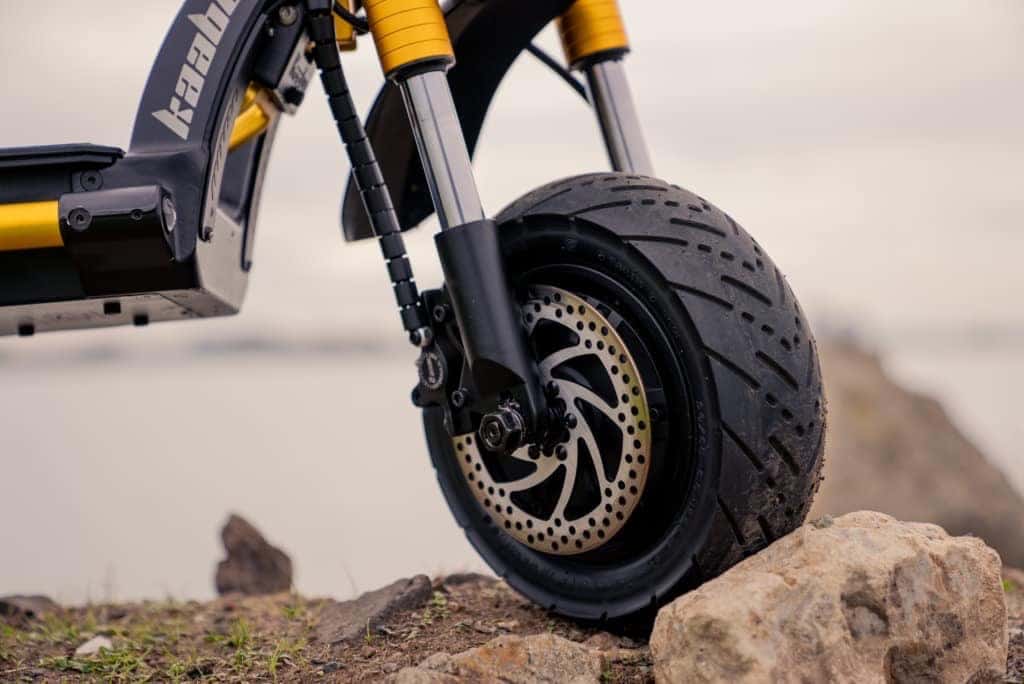
A quality braking system is essential for staying safe and in control while riding an electric scooter. Like those on a car or bicycle, brakes are what slow the electric scooter down. Electric scooter brakes can be broken into two categories: mechanical and electronic.
Mechanical brake systems are those that rely on a physical mechanism to slow the scooter down and include foot, drum, and disc brakes. The typical 15 mph stopping distance for mechanical systems is 20 feet, with the absolute best being under 10 feet.
- Foot brakes, which are activated by pushing your foot down on the rear fender, cause it to rub against the rear tire, slowing it down. This type of brake has stopping power but is not as effective as drum or disc brakes.
- Drum brakes are enclosed inside the wheel hub, are generally lower maintenance than other braking types, and have consistent performance in wet conditions.
- Disc brakes have the most stopping power and are lighter than drum brakes. They are typically found on higher-end premium commuter and high-performance scooters, but may appear on better quality budget commuter scooters as well.
- In our real-world road tests, we found disc and drum brakes to be the most effective.
Electronic braking systems rely on using the motor itself for braking and include strictly electric and regenerative braking systems. Electric and regenerative brakes are the weakest. If you are traveling at 15+mph and need to stop quickly, these alone will not do the job. The typical 15 mph stopping distance using an electronic brake alone is 30 to 40 feet.
Mechanical braking systems will offer much stronger braking than electronic systems. However, electronic systems benefit from not requiring any periodic adjustments or maintenance. Many scooters will have a combination of both electronic and mechanical braking systems. For safety reasons, we recommend scooters that have at least two braking systems in case one fails.
Learn more in our technical guide to electric scooter brakes.
Tires
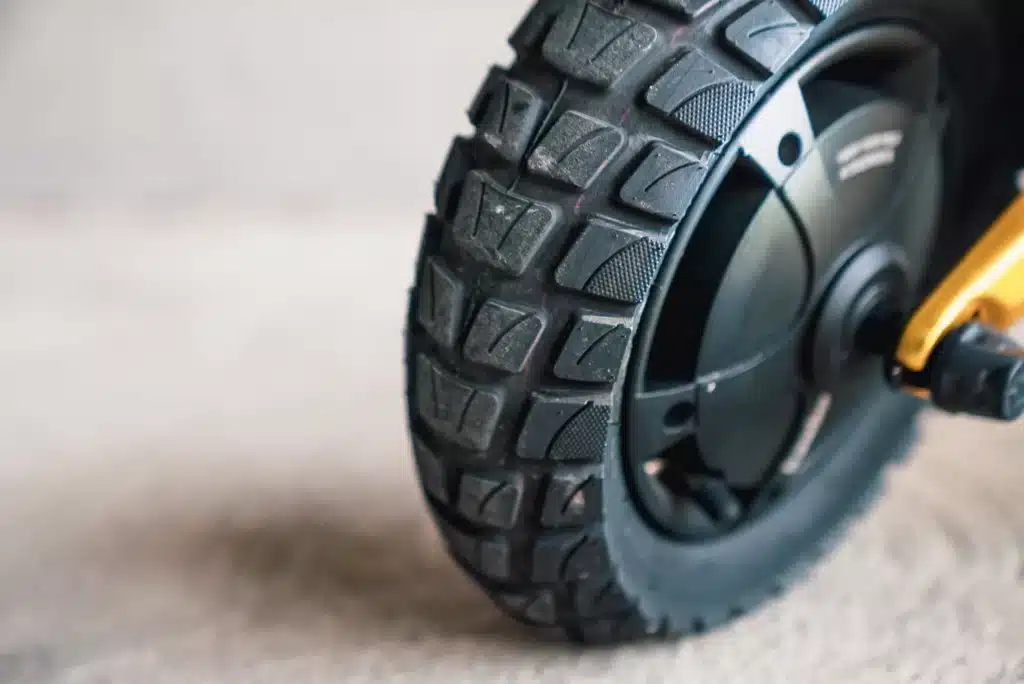
Tires come in two types: solid (airless) tires and pneumatic (air-filled) tires.
Solid tires are what they sound like, often made of rubber, foam, or other flexible material. There are a few varieties of airless tires, and these include honeycomb, polymer-filled, and solid. Solid tires are inferior to pneumatic tires in every way except that they require virtually no maintenance and cannot go flat. The disadvantage of solid tires over air-filled tires is that they provide poor traction and ride quality; you’re more likely to feel every bump and even stumble over lines of paint on the road (lol).
Pneumatic tires or air-filled tires We always recommend pneumatic tires because they give better ride quality (with or without suspension), and their supple rubber performs much better in adverse road conditions (especially in bad weather). Some air-filled tires have inner tubes that can be replaced if damaged; while others are tubeless.
The downside to pneumatic tires is that they require more maintenance than the airless variety. Not only do you need to check the tire pressure periodically, but these tires are also prone to punctures (especially the ones with inner tubing).
On scooters, it’s often the rear tire that endures the brunt of our weight, and you’ll likely see this where there are more flats. Some manufacturers have devised a solution where the front tire is filled with air, and the back tire is solid. This way, you won’t have to deal with annoying flats as often.
Pneumatic tires, with tubes and tubeless, are common in all price classes except the budget range, where tires are almost exclusively solid.
Learn more about the differences between pneumatic and solid tires in our electric scooter tire guide.
Pro Tip: Do not underestimate the improved ride quality you will get with pneumatic tires. They will make a huge difference when going over even slightly bumpy terrain, where the vibrations from the road can make your feet and hands very uncomfortable. If you are afraid of the occasional punctures, there are a few simple tips you can follow to prevent flat tires on your electric scooter.
Electric scooter wheels come in various sizes ranging from 6 to 16 inches. 6-inch wheels are typically found on kid’s scooters, while 8.5 inches is considered the optimum size for entry-level models. As you move up the performance ladder, wheel sizes will generally increase.
In general, bigger wheels are more stable and can roll over obstacles better. However, if portability is your main concern, you should stick with smaller wheels.
An 8.5-inch wheel is ideal for portability without sacrificing much in terms of stability, whereas larger diameter options (10+ inches) are preferable for maximum performance, better handling, and off-road capabilities.
IP Rating
If you’re thinking of buying an electric scooter that’s suitable for all weather conditions, then it pays to familiarize yourself with the IP rating. The two numbers in the rating let you know how well your vehicle can handle dust and moisture; the first character indicates protection from solid particles such as dust and debris, while the second character describes water resistance from rain, splashing, and immersion. The higher the number, the better your scooter will be protected from dust, moisture, and splashes.
Not all electric scooters have an IP rating reported by their manufacturers, but if you’re planning on riding in a range of different conditions, then make sure you choose one with an IPx4 rating or above. Currently, the most highly resistant model we’ve tested is the Apollo’s City Pro scooter, which has an impressive IP56 rating!
Read our guide on Electric Scooter IP Ratings.
Pro Tip: You can sort our electric scooter comparison database based on IP rating (the column is titled “Water”). And if you wish to go the extra mile in finding a water-resistant scooter, don’t forget to check out our editors’ picks for the best electric scooters for riding in the rain.
Warranty and Customer Support
A warranty will be your lifeline should any problem arise down the road. Many companies offer some type of limited warranty on their electric scooters so make sure to read the fine print to understand what’s covered by a warranty before buying.
As part of our RG certified scooter review process, we evaluate and outline warranty offerings, including length of term and inclusions. We also learn about the distributors and scooter brands directly from e-scooter riders. Read on which brands have proven brand satisfaction in our article on the best scooter brands.
Along with a strong warranty, dedicated and responsive customer support is an excellent benefit when purchasing an electric scooter. As you familiarize yourself with your new device, you may have questions or concerns about how to properly care for and repair it. Exceptional post-purchase customer support is not available from all distributors, so it’s important to understand the pros and cons depending on which brand you buy from where.
How Long is an Electric Scooter Warranty?
Electric scooter warranties typically vary between brands, but can range from 6 months to 2 years. One of the best warranties we’ve seen is from NIU Scooters, who offer an impressive 2 year warranty on all their scooters, that covers even the most expensive parts–the battery, dash and controllers.
Maintenance and Repairs
Maintenance can be a hassle if you don’t purchase a reliable scooter with parts that are easily accessible. Fortunately, there are many brands out there that offer excellent build quality and easy-to-find replacement parts. Uscooters, for instance, is well known for its reliability and ultraportable scooters.
Look into the company’s reputation and see what other customers say about their experiences with the product. Find out how long it takes for the manufacturer to provide replacement parts and how much the repairs cost.
Look for an electric scooter that has a durable frame and components that are built to last. High-quality materials such as aluminum alloy or stainless steel are ideal because they are strong but lightweight at the same time. You also want to diligently avoid models with lots of plastic components, as one rough fall could mean replacement parts at a hefty cost.
How Frequent are Electric Scooter Repairs?
Even the most durable electric scooters will require upkeep. Our owner survey data indicates that most people have two issues per year or every 600 miles requiring maintenance. The most common parts needing repair are tires (flats, low tread), brakes (brake pads, brake adjustments), and fenders (broken, loose).
Preventative Maintenance on the Electric Scooter
Proactive tune-ups can save you a lot of trouble in the future. Though most electric scooters don’t require regular maintenance on most of their parts, you may need some on your tires or certain bolts.This can include checking and tightening all nuts, bolts, and screws periodically and checking tire pressure and tread depth. In addition, it is important to check for worn parts or components that may need replacing. You should also inspect wires and cables for signs of wear or damage.
DIY Another thing to keep in mind is that there isn’t a good infrastructure in place for electric scooter repair as the industry is just forming, so the best option for regular maintenance and repairs is often doing it yourself.
Pro Tip: If you are looking for repair, maintenance or upgrade information, check out our detailed technical guides for electric scooters (more are being added all the time).
Here’s more on where you can get your electric scooter repaired.
Safety
Scooters and mopeds have recently been in the news, not just for popping up worldwide in shared services but for causing serious injuries and even death.
If you’ve been in cities with shared scooter services, you know that helmets do not come with the package, and the unexpected surge in accidents is largely happening in the shared scooter market. Often with first-time riders, the most serious injuries involve impacts to the head, which a helmet can mitigate.
According to scooter-related injury reports, an astounding 82.7% of falls would have been avoidable had the rider used better technique and worn protective gear like a helmet. This highlights how vital it is for riders to get comfortable with their scooter before heading out on their own, and also to always wear a helmet, as well as other protective gear such as elbow and knee pads, gloves, visibility vests, etc.
It’s also important for riders to be aware of potential hazards like uneven terrain or potholes which can cause them to lose control or fall off their scooter if not navigated properly. Learning how to brake safely and effectively is also essential Additionally, staying alert while riding will help you stay safe by giving you more time to react if there are sudden obstacles in your way or unforeseen changes in traffic patterns. It’s also wise to plan ahead by learning your route beforehand so that you can be prepared when dealing with turns or intersections in unfamiliar areas.
Get more Tips on How to Ride an Electric Scooter as a Beginner
Where To Buy an Electric Scooter
Where you buy an electric scooter can be almost as important as what you buy. When deciding who to buy from, you have a few options.
- Some people choose to go the traditional route and pick up their vehicle at a brick-and-mortar store, like PEV stores, Department stores, e.g., Macy’s, Target, or big box retailers, e.g., Best Buy, Costco.
- Others opt for the convenience of shopping online, where they can purchase their electric scooter directly from
-
- Speciality distributors (e.g. Apollo, Fluid Freeride, VORO Motors, Alien Rides, Electric Kicks)
-
- Big box (e.g., Amazon)
-
- Direct to Consumer Brands
- In recent years direct purchases from China have become increasingly popular with shoppers looking to save money, who are willing to take longer wait times in exchange for lower prices via sites like AliExpress and Alibaba.
- Crowd-funded Campaigns
Domestic Distributor
The RG Editors tend to favour buying from a good domestic distributor, even though it will generally cost more. Not only do these distributors tend to provide excellent warranties, but they also provide customer support for troubleshooting, repair, and parts replacement.
What’s more, by buying from a domestic source, you will have peace of mind knowing that all products must pass stringent safety protocols and performance tests to receive authorization in the country they are being sold in.
The following are the main ways you can purchase an electric scooter from your local distributor:
Brick and Mortar
Generally, the benefits of buying domestically are fast shipping and better post-purchase support. The main disadvantage is that buying domestically is usually more expensive than directly from China, and you also get a smaller scooter selection.
However, shopping in person allows customers to get a better feel of the product they’re purchasing and allows them to ask questions and discuss any concerns with store personnel. Furthermore, local PEV stores tend to have more knowledge about the products and specialized parts that can serve as customer resources.
Online
You can also have access to a domestic distributor through their online options.
Shopping online is incredibly convenient and straightforward. You have access to the latest models from quality brands, and you can be sure of finding exactly what you’re looking for by comparing different makes and models.
There are plenty of websites platforms that can help in your search; these include
Big Box stores/Online Retailers
Buying electric scooters through online retail giants like Amazon and Alibaba definitely has its perks. It’s usually the most convenient way to get your hands on a new scooter, as you can almost always count on the fastest shipping, unbeatable prices, easy returns, and a wide selection. However, remember that once the return window has closed (typically after 30 days), you’ll have to rely on the manufacturer for post-purchase support; Amazon dealers rarely provide this.
Also, note that when retailers can offer such low prices, there’s a small catch. Customers often have to sacrifice services like personalized customer service or dedicated mechanics. This means that the cost of these services ends up being shifted back to the consumer in one way or another, either through extra charges.
This approach, however, works well for scooter companies because it allows them to reduce distribution costs while still getting their products into buyers’ hands quickly and cost-effectively.
Specialty Distributors
Specialty distributors are online retailers that import, sell, and provide post-purchase support for electric scooters. Apollo, Fluid Freeride, VORO Motors, Alien Rides, and Electric Kicks are some of the most well-known specialty distributors, each specializing in a specific brand and providing an excellent balance of price and post-purchase support.
Specialty distributors are a great option because they tend to know more about specific models than general retail stores or online marketplaces.
They also offer tips and help with any technical issues that may arise. Many of these companies even have specific repair services available for their customers if they need them.
Direct to Consumer Brands
Why not go directly to the source?
While several brands choose to partner with a retailer or distributor, you can also buy an electric scooter directly from the manufacturer. Popular electric scooter manufacturers like Apollo, Unagi, NIU, Anyhill, Solar, Segway, and GoTrax all offer the option to buy their products directly from them.
Buying an electric scooter directly from the manufacturer can provide you with unbeatable quality, customer service, and warranties that are often superior to those offered through retail partners or distributors.
Direct from China
Cost savings is a major draw for customers when purchasing items from China. However, some drawbacks to this approach should be considered before making a purchase.
- Slow shipping time It can sometimes take months to receive an order.
- Meager customer support If there is a major problem, you will not be able to return the scooter, though they may be willing to ship you parts to perform repairs yourself. Moreover, buyers will likely have no recourse if there are problems with the product once it arrives or during shipment since they have no way of getting back in contact with the seller or manufacturer.
- Brand authenticity there is no guarantee that the product you buy is 100% authentic – it may actually be a clone of the branded model, with some parts being identical but others not up to the same standard.
- Additional costs related to shipping and customs clearance. These costs can significantly add up over time and reduce any money saved by purchasing directly from the distributor.
Crowdfunded Campaigns
Backing a crowdfunded electric scooter campaign on Kickstarter or Indiegogo can be a very exciting prospect. You can help support new and innovative products — and often get them at a steep discount over what their retail would be.
However, we strongly recommend against backing crowdfunded campaigns unless you are 100% prepared to lose all your money or are willing to wait one to two years for a product.
The history of electric scooter crowdfunded ventures has been fraught; numerous campaigns such as Eon and Unicorn have failed outright, leaving backers empty-handed. Nearly 500 Kickstarter supporters eager to get their hands on the Raine One electric scooter were disappointed in 2021 when the Raine Team announced they would not be issuing refunds even though they were unable to complete production on a single scooter.
Even successful campaigns have burned sellers. Inboard used crowdfunded dollars as an interest-free loan to develop their product, which they decided to release only to the shared market. Mercane led a successful campaign for the WideWheel, but years later, many backers claim they still haven’t received anything despite the WideWheel being available to consumers worldwide.
Beginner’s Electric Scooter Buying Guide: Summary
In conclusion, purchasing an electric scooter is a decision that should be tailored to the rider’s individual needs. It requires some research into components like range, budget, weight, motor wattage, brakes, tire type, and purpose of the scooter. Suppose it is your first time buying an electric scooter. In that case, we suggest you start with something that:
- Has atleast a 15-mile range.
- A top speed above 13.5mph.
- Weighs less than 40 lbs.
- Should have basic lighting.
- Has a 300-watt motor (or larger).
- Dual braking system with atleast one quality braking system (drum or disc)
- Has a front or rear pneumatic tire (if not both) with a wheel size of atleast 8.5 inches.
- IP rating of atleast IPX4.
In case you decide to upgrade your model down the line, we have offered details on different price categories as well as our top three to four recommendations in each category. We have also offered all the specs of each scooter, along with purchase links and sweet discount codes for your convenience.
When in doubt, join the Electric Rider Guide Facebook Group for more information and support from other like-minded riders. The RG website also has plenty of resources with detailed, in-depth reviews that can help make your buying decision easier.
Feel free to reach out with any questions or if you need additional support selecting your first electric scooter! And above all else, remember to stay safe every time you get behind the bars of your powerful new scooter. Thanks for checking out our blog post, and good luck shopping!


At Surron Bike supply, we ride ahead of the world. Our unique electric off-road bikes are revolutionizing the riding experience.
Are you ready to ride with us?
#surron#surronlightbee#surronx#surronbike#surronebike#surronindonesia#surronstorm#surronlightbeex#lightbee#surronphotos#lightbeex
https://surronbikesupply.com/product/talaria-sting-l1e/